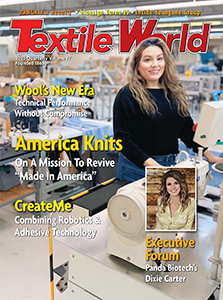TEGUCIGALPA, Honduras — September 19, 2017 — Honduras’ textile and apparel sector has attracted $1.5 billion in strategic investments to help transform the country into one of the world’s major players in the booming synthetic yarn and activewear market.
The funds have been used to modernize sewing machines and other equipment, expand industrial parks, improve port and road infrastructure, train workers, and build renewable energy facilities with the goal of slashing electricity costs, according to Ramfiz Rodriguez, international promotion and communication manager of Honduras2020, a public-private partnership to stimulate economic development. The goals for the textile sector, one of Honduras2020’s strategic pillars, include increasing annual exports to US$7.4 billion and adding 200,000 jobs to the existing 150,000 by 2020.
Several Honduran investors pooled $73 million in January to launch the synthetic texturized yarn production plant United Textiles of America (Unitexa), slated to begin operations in the summer of 2018. The plant will have the capacity to produce more than 25,000 tons per year of Drawn Texturized Yarn (DTY) in a range of dimensions and textures, to be used for the elaboration of synthetic sport, moisture-wicking, stain-resistant and other high-performance fabrics for clothing and footwear. Rodriguez says synthetic textile manufacturing lead times and costs will become even more competitive once the high-tech yarn is produced locally instead of imported.
According to Rodriguez, Honduran textile giant Elcatex and others are ramping up synthetics output in Honduras, while several US, Chinese and European investors are already considering opportunities both in synthetics manufacturing facilities and in distribution centers to service e-commerce. Several plants in the country have already incorporated new technologies for the use of recycled synthetic fibers.
Rodriguez says that with more than 30 years of experience in the industry, Honduras is Central America’s top textile exporter. According to the Honduran Maquiladora Association (AHM), it is hoped exports of textiles and clothing will increase from US$4.1 billion in 2016 to US$4.5 billion this year. The industry is one of Honduras’ main export and employment generators, comprising nearly 260 companies operating in 16 industrial parks.
Some 83 percent of Honduran textile exports are destined for the US market, Honduras2020 data shows. The country is the US’s number one supplier of cotton T-shirts and number two supplier of fleecewear, according to the United States Trade Office. Honduras’ goal is to surpass Indonesia and Mexico to become the United States’ fifth most important apparel provider, Rodriguez explained.
Multinational textile companies operating in Honduras include Fruit of the Loom, which established itself in 1993 and now operates eight production plants across the country. Hanes operates 13 industrial plants and has been established in Honduras for more than a decade. The Canadian company Gildan Activewear, which initiated operations in Honduras in 1997, has chosen Honduras as the site of many of its modern manufacturing facilities for socks, sportswear, underwear and screen printing, and is preparing to build a new textile plant to increase its production capacity, according to Rodriguez.
Proximity to the United States, competitive production costs, a highly specialized labor force, low worker attrition, ongoing worker training, product quality, the adaptability of production facilities to changing consumer tastes, attractive tax benefits and environmental and social sustainability practices are some of the reasons foreign companies cite as their reasons for producing in Honduras, Honduras2020’s international promotion and communication manager explains. Preferences granted to Honduran textiles under the Free Trade Agreement of Central America (CAFTA) include free access to the US market.
Infrastructure has been another priority, with significant investments being made in Puerto Cortes — the only deep water port in Central America and the first in Latin America with CSI and Megaport certifications from the US government — as well as in the highways leading to and from it. Puerto Cortés is being expanded to double its cargo management capacity to more than 1.2 million twenty-foot equivalent units (TEUs), according to Honduras2020.
Honduras has also invested heavily in technology to ensure the sustainability of textile manufacturing. All textile production plants treat and recycle the water and salt used in the fabric dyeing process, says Rodriguez. Elcatex operates Latin America’s largest above-ground photovoltaic generator, with a capacity of 7.5 megawatts, in addition to using other renewable energy sources such as biomass.
As part of a public-private partnership, affordable housing is being developed for textile workers near several industrial parks around the country. The housing is located in gated communities featuring schools, parks, day care centers and recreational facilities.
Posted September 20, 17
Source: Honduras2020




